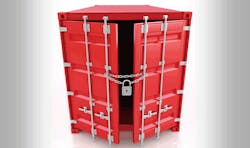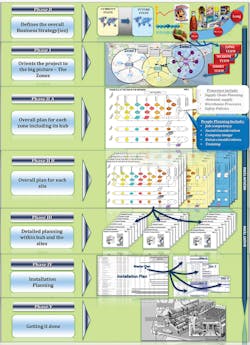The Art of Survival in a Supply Chain Ecosystem
The last five years proved we are more vulnerable to global events than we ever imagined. Even if you never felt the direct impact, chances are you experienced second and the third degree effects. This should remind us we all live in an "Ecosystem." This is because supply chains are built by engineers, not psychologists or political science professionals. Their aim is to maximize the benefits accrued by a highly organized network of partners. The rewards of such a self-organized system are high, but so are the risks. Highly complex self-organized systems get into a state of what we call "Armageddon," a point which exponentially increases the impact.
Success is owed to the joint/multiplicative factor of probability of all supply chain partners. But it is staggering to see that one partner may recover while the overall supply chain success is only 64%. This includes a different type of thinking and maturity in the supply chain and hence a need for a comprehensive framework to assess risks.
Executives are always focused on tackling organizational challenges but rarely tend to look at cross boundary problems—partly because they're difficult to pinpoint. It is also time consuming to define roles, responsibilities and accountability for a string of businesses you don't manage directly.
Three Disaster Levels in Ecosystems
Internal (within an organization) - A failure in one node or even a secondary node can threaten to cascade across the system and undermine strategic capacity.
External (how your partners and counterparts behave) - Resiliency not only depends on how effectively a partner(s) responds but how well others manage to navigate the system.
Interconnectedness (how it all comes together as a whole) - The world we live in is far more interrelated. Even if you are directly linked, you could experience what we call second and third degree influence.
Cue from the White House
To understand these vulnerabilities and create a transparent collaborative framework, both private sector and public sector organizations came together in the mid-Atlantic region under an initiative sponsored by the Federal Emergency Management Agency (FEMA). The goal was to:
- Create a framework that clearly defines all roles, responsibilities and accountabilities;
- Devise a robust plan that could easily adapt to varying degrees of vulnerabilities; and
- Implement a platform that is standardized both internally and externally across the ecosystem.
Working through the Regional Catastrophic Preparedness Grant Program (RCPGP) Mid-Atlantic Supply Chain Resilience Project, the Shared Intellectual, Inventory, Infrastructure, Information and Integrated Ecosystem Systems (SI5ES) developed by the authors was adopted for exploration.
SI5ES facilitates communication, collaboration and exercises among key partners and with the public sector. Its methodology frames supply chain risk problems and is especially suited for an unknown context, such as an emerging market or a catastrophic event.
Phase Implementation
To understand the effectiveness of the SI5ES, it is vital to look at each of its six phases of initiation.
Phase 0: Define the strategies - The purpose of this phase is to understand the relationship of catastrophe preparedness to corporate strategy, business planning, competing priorities, pricing and other core initiatives. Some key considerations include: who are the key customers, what is the key local market landscape, what is the collaborative environment the company lives in and what is the time horizon of a catastrophic event.
Phase 1: Understand the big picture - Supply chain zones are typically characterized by a coherent set of operating assumptions regarding the availability and flow of product and services. Additionally, they are often organized to minimize reliance on other zones. Relationships within a zone are functionally and contractually organized around these assumptions and their expected persistence. In the geographic region impacted by the potentially catastrophic event, it is important to understand:
- How have the pre-event assumptions been changed by the potentially catastrophic event?
- Do the zones involved have sufficient strategic capacity to recover and potentially redirect local capabilities?
Phase 1 defines the pre-event distribution network strategy, builds a comprehensive model to understand the interdependency and determines cost, price, and margin implications.
Phase 2: Analyze supply chain zone, hubs and sites - The core of every zone consists of hubs, which equate to the principal nodes of the supply chain network. Determining the strategic capacity of each individual hub involves understanding:
- what processes are accomplished;
- what capabilities exist;
- what interdependencies facilitate the processes and capabilities;
- time sequences and sensitivities related to processes, capabilities and interdependencies for each hub.
This supply chain preparedness methodology differs from others in that it focuses on the fundamentals and on the role of the lead component. Traditional problem solving steps include gathering, analyzing and synthesizing. Engaging these fundamentals by subject area—such as infrastructure, process and people—establishes an overall preparedness framework by zone. Secondly, a supply chain preparedness framework is generated by fixing a lead component—something that needs to be considered as a given or a constraint. Analyses of each subject area are then integrated to develop an overall hub picture.
The methodology ties all subject areas and their concepts together. Infrastructure is the hardest and most tangible subject and pivotal analysis is performed around it while people and process are tied in. Ignoring one or all aspects is a common mistake and results in less than optimal preparedness.
In case of a catastrophe, it is important to identify which supply chain characteristic is most likely to present the greatest constraint: infrastructure, processes or people?
While developing the analysis for a network hub, it is critical to identify how sites mature with time. While the traditional role of the sites is to provide value-added activities—such as late-stage order fulfillment with improved demand data—they can also be a buffer against uncertainty in supply performance. Uncertainty can involve demand volatility which requires an effective respond/recover strategy as well as supply chain redundancy/resiliency. Such redundancy is a critical consideration especially during start-up stages and for longer-term resilience.
Phase 3: Identify supply chain resilience priorities for zones, hubs and sites - Based on the emerged understanding from the prior phases, how can one describe the strategic reality of the zones and hubs? The key is to apply the strategic frameworks developed as a part of phase II and add more detail. At this phase, this translates into the slotting plan for the picking area. What does this process expose in terms of assumptions, expectations and mitigation opportunities?
During Phase three, it is imperative to define the requirements which will achieve your end-state goals. This is followed by a careful exercise to pare down requirements, resulting in a simple working model, while concurrently enabling significant resilience without sacrificing cost and service. Engineers or supply chain practitioners can easily overload features, functions and details that add complexity. Beware of the temptation to over-complicate details as it could increase the likelihood of cascading failure in case of potential catastrophe.
Phase 4
Phase 4: Develop supply chain mitigation and a preparedness framework - This phase specifies the requirements and results in a master supply chain mitigation and preparedness framework with tasks, resources, times, sequence and interdependencies. This framework should include:
- Clearly defined tasks, accountabilities, expectations, timelines and interdependencies;
- A common glossary of terms;
- Reporting at right levels scorecards on the progress, obstacles in achieving the goals, conflict resolution, clearly defined escalations and priority management.
Clearly defined communications, forums and participants have to be established well in advance to ensure that the right partners are involved at all steps. Tasks defined as a part of the master plan should be relevant, measurable and include clearly defined hand-offs and output expectations. Each master framework should have multiple alternatives in place for unforeseen problems, as well as a process for identifying opportunities to break up interdependencies between tasks.
Phase 5: Resiliency program execution - The final phase is coincidental with a potentially catastrophic event. The frameworks previously developed are implemented to restore or redirect supply chains and, if possible, recover supply chain strategic capacity and local capability. It is highly recommended to actively review and renew the prior phases of work.
Process evaluation includes all processes, communications, personnel engagements, conflicts and scope management. It essentially asks: ‘If we had to do this all over again, what would we do differently? What should and shouldn't we have done?'
Getting ready for a potential catastrophe includes putting together a systematic readiness checklist for infrastructure, process and people. It's critical to check that each of these components works in the exercise phase.
Even the best plan could turn into money down the drain without people who understand and value their purpose in a crisis event. These people must pledge their buy-in, including a personal acknowledgment of the importance of their ability and responsibility. Having a valued role backed up by the old—but effective—expectation of "practice, practice, practice" until it is second nature will help spread security supply-chain-wide.
Ron Hammond is Global Supply Chain Vice President at GOJO Industries Inc. (www.gojo.com). He has 30 years of senior level general management, supply chain and manufacturing operations experience.
Shekar Natarajan is the North American senior director of supply chain planning for Anheuser Busch and a member of MH&L's Editorial Advisory Board.

